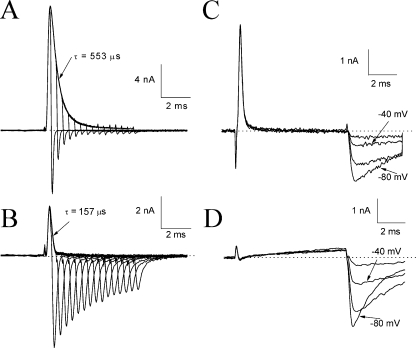Figure 9.
Competition between β4154–167 and the intrinsic fast inactivation particle. Current traces of wild-type Na+ channels in the absence (A) and presence (B) of 1 mM β4154–167 were recorded at 50 mV with duration varying from 0.4 to 6.0 ms and were superimposed. The pulse protocol was the same as shown in Fig. 5 A. The outward current in A and B decayed with a τ value of 0.157 and 0.553 ms, respectively. Evidently, the time-dependent block induced by β4154–167 also occurred in wild-type Na+ channels. The tail current of trace 15 in A (P15) was barely detectable, but in B was quite large and significantly slower in its decay kinetics when 1 mM β4154–167 was present. Resurgent currents were recorded from wild-type Na+ channels at voltages ranging from −80 to −20 mV with a 20-mV step (C). The pulse protocol is the same as shown in Fig. 6 A. The pipette solution contained 1 mM β4154–167. Experiments were repeated in eight cells with similar results under the reversed Na+ gradient condition (65 mM Na+ ions in the bath and 130 mM Na+ ions in the pipette). (D) Current traces were recorded in the presence of 1 mM β4154–167 as described in C except that the bath and pipette solutions had 130 and 13 mM Na+ ions, respectively. Although Na+ currents at 50 mV were minimal under the normal Na+ gradient condition, the resurgent currents remained robust near the activation threshold. This experiment was repeated in five cells with similar results.

